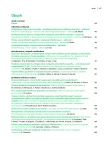Why and how do insulin agents act on weight
Authors:
Štěpán Svačina
Authors‘ workplace:
III. interní klinika 1. LF UK a VFN Praha, přednosta prof. MUDr. Štěpán Svačina, DrSc., MBA
Published in:
Vnitř Lék 2014; 60(5-6): 448-453
Category:
Review
Overview
The weight gain in insulin therapy is known phenomenon for decades. Different types of insulin and insulin analogues differ in many clinical effects, e.g. duration of action, risk of hypoglycaemia and effect on the weight as well. These effects vary with change of insulin for insulin analogues and vice versa. It has been unclear for a long time why some insulin analogues have positive effect on weight gain. Currently, it is obvious that several factors are crucial: binding to albumin, reduction of hypoglycaemia events, dissociation between hepatic and peripheral effects, influence on renal function and differences in action of insulin in brain. Therefore, we know how to use beneficial effect of particular agent in daily practice. In addition, we know pathogenetic mechanisms that influence the weight – in other words, we can answer the question why and how does particular agent change the weight.
Key words:
binding to albumin – fluid retention – hypoglycaemia – insulin – insulin analogues – insulin in brain – weight
Sources
1. Inzucchi SE et al. Management of hyperglycaemia in type 2 diabetes: a patient-centered approach. Position statement of the American Diabetes Association (ADA) and the European Association for the Study of Diabetes (EASD). Diabetologia 2012; 55(6): 1577–1596.
2. Svačina Š. Přístup zaměřený na pacienta – cesta k opravdové individualizaci léčby diabetu. Nová doporučení ADA/EASD z české perspektivy. Med Promoci 2012; 13(4):49–52.
3. Svačina Š. Význam struktury inzulinových přípravků pro klinickou praxi. Vnitř Lék 2009; 55(4): 409–411.
4. Plank J, Bodenlenz M, Sinner F et al. A double-blind, randomized, dose-response study investigating the pharmacodynamic and pharmacokinetic properties of the long-acting insulin analog detemir. Diabetes Care 2005; 28(5): 1107–1112.
5. Hartman I. Insulin analogs: impact on treatment success, satisfaction, quality of life, and adherence. Clin Med Res 2008; 6(2): 54–67.
6. Schreiber SA, Haak T. Insulin glargine benefits patients with type 2 diabetes inadequately controlled on oral antidiabetic treatment: an observational study of everyday practice in 12,216 patients. Diabetes Obes Metab 2007; 9(1): 31–38.
7. Hollander P, Cooper J, Bregnhøj J et al. A 52-week, multinational, open-label, parallel-group, noninferiority, treat-to-target trial comparing insulin detemir with insulin glargine in a basal-bolus regimen with mealtime insulin aspart in patients with type 2 diabetes. Clin Ther 2008; 30(11): 1976–1987.
8. Niswender K, Piletic M, Andersen H et al. Weight change upon once-daily initiation of insulin detemir with or without dietary intervention in overweight or obese insulin-naïve individuals with type 2 diabetes: results from the DIET trial. Diabetes Obes Metab 2014; 16(2): 186–192.
9. Hordern SV, Wright JE, Umpleby AM et al. Comparison of the effects on glucose and lipid metabolism of equipotent doses of insulin detemir and NPH insulin with a 16-h euglycaemic clamp. Diabetologia 2005; 48(3): 420–426.
10. Svačina Š. Obezitologie a teorie metabolického syndromu. Triton: Praha 2013. ISBN 978–80–7387–678–4.
11. Hendriksen KV et al. Effects of insulin detemir and NPH insulin on renal handling of sodium, fluid retention and weight in type 2 diabetic patients. Diabetologia 2012; 55(1): 46–50.
12. Schwartz MW, Porte jr. D. Diabetes, obesity, and the brain. Science 2005; 307(5708): 375–379.
13. Hallschmid M et al. Euglycemic infusion of insulin detemir compared with human insulin appears to increase direct current brain potential response and reduces food intake while inducing similar systemic effects. Diabetes 2010; 59 : 1101–1107.
14. van Golen LW1, IJzerman RG, Huisman MC et al. Cerebral blood flow and glucose metabolism in appetite-related brain regions in type 1 diabetic patients after treatment with insulin detemir and NPH insulin: a randomized controlled crossover trial. Diabetes Care 2013; 36(12): 4050–4056.
15. Carvalheira JB, Qiu Y, Chawla A. Blood spotlight on leukocytes and obesity. Blood 2013; 122(19): 3263–3267.
16. Svačina Š. Metabolické účinky psychofarmak. Triton: Praha 2004. ISBN 80–7254–599-X.
17. Jansen HJ, Stienstra R, van Diepen JA, Hijmans A et al. Start of insulin therapy in patients with type 2 diabetes mellitus promotes the influx of macrophages into subcutaneous adipose tissue. Diabetologia. 2013; 56(12): 2573–2581.
Labels
Diabetology Endocrinology Internal medicineArticle was published in
Internal Medicine

2014 Issue 5-6
Most read in this issue
- Adult-onset Still’s disease – a difficult path to diagnosis through fever and effusions of unknown origin
- Purple urine bag syndrome – rare but substantial symptom of urinary infection
- Diffuse Idiopathic Skeletal Hyperostosis
- Sentinel lymph node in malignant melanoma
